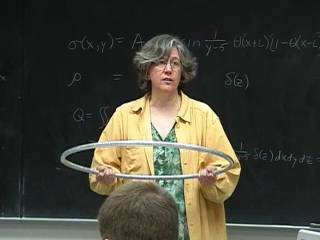You are here: start » activities » main
Magnetic Field Due to a Spinning Ring of Charge
Highlights of the activity
- This small group activity is designed to help students connect much prior learning in a single problem involving magnetic fields.
- Students are asked to create an integral expression for the magnetic vector field everywhere in space caused by a ring with total charge $Q$ and radius $R$ spinning with period $T$ and to develop the power series expansion for the potential near the center or far from the ring.
- The wrap-up discussion focuses on how to deal with a vector cross product in an integrand.
Reasons to spend class time on the activity
This is designed as the culminating activity for this unit which allows students to connect much prior learning in a single problem. Prior to upper division physics courses, students have little experience in dealing with anything involving the synthesizing or “pulling together” of so many things simultaneously. Students need to use symmetry and geometric understanding to be able to construct the integral using the Biot-Savart Law. For many students, this will be the messiest integral they have ever had to face (see Eq. 6 in the solutions for this activity). Successfully unpacking (dealing with) this integral requires that students first believe that they are capable of tackling something like this.
The primary new piece to the problem is the vector cross product in the numerator of the integrand. Although students have done vector cross products in math classes, students will need to realize that they can apply vector cross products to this context and that doing so will help make the problem more manageable. There is ample opportunity for algebraic errors while taking the cross product, including sign errors, losing track of $\phi$ vs $\phi'$, and failure to recognize the trigonometric identity ${\cos\phi}\,{\cos\phi'} + {\sin\phi}\,{\sin\phi'} = \cos(\phi - \phi')$. However, students should be encouraged to recognize that they have all the fundamental pieces to understanding this problem along with the ability to put them together, and that they simply need to work carefully in order to obtain a correct solution.
